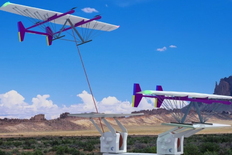Sailrocket 1 was built to capture the sailing speed record competing in the B-class for 150 to 235 sq. ft. of sail.
During the 8 years of Sailrocket 1's design and development the bar was raised to 40 knots, and then to 50. Sailrocket 1 briefly held the B-class speed sailing record in December 2008, with an average of 47.4 knots over 500m in Walvis Bay.
Chris Hornzee-Jones is the designer of its unique wing sail. He had previously developed and built his own light-weight bi-plane. Based on this practical experience Chris proposed the first rigid wing for Sailrocket 1, favouring materials similar to his hang glider, namely a tubular carbon spar, lightweight foam sandwich ribs and Mylar film covering. Aerotrope engineers carried out configuration design, aerodynamic and structural engineering studies to optimally match the wingsail to the boat.
The main innovation of Sailrocket's concept is the way in which the sail and keel elements are positioned so that there is virtually no overturning moment and no net vertical lift. We knew that, when used correctly, this concept results in a boat which no longer has obvious stability limits and in which the only significant response to gusts is an increase in speed!
After tow testing Sailrocket to measure the boat's hump drag, we settled on 16m² wing area as sufficient for lift-out and high speed. With the aerodynamic configuration fixed, we applied the same criteria of practicality and performance to the structural design.
A monocoque sandwich shell would have assured an excellent shape all over, but is vulnerable and hard to repair when built down to the weight target of 45kg. It would also have needed large expensive moulds.
The spar provides a reliable and robust structural spine that can carry compact fittings for the mast foot, stays etc. The leading edge is a non-structural fairing that can be repaired more readily than a structural shell if it gets damaged. The whole wing was completely 3D modelled in CAD, allowing us to extract the profiles for the ribs and webs to be cut out of flat panels.











